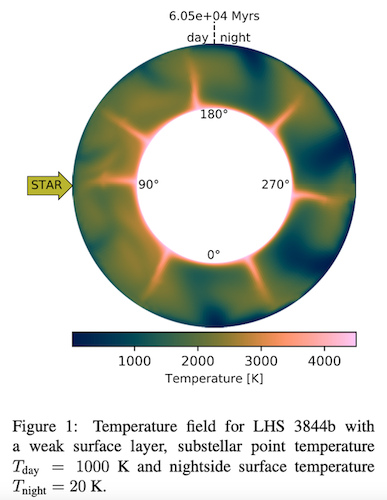Interior dynamics of tidally locked super-Earths: The case of LHS 3844b
- 1Universität Bern, Center for Space and Habitability, Bern, Switzerland (tobias.meier@csh.unibe.ch)
- 2Atmospheric, Oceanic and Planetary Physics, University of Oxford, Oxford, United Kingdom
- 3Institute of Geophysics, ETH Zurich, Zurich, Switzerland
Abstract
Ultra-short period planets (USP) that are rocky in nature are plentiful in the exoplanet catalogue and may host tectonic regimes without analogues in the Solar System. Recently, the transit phase-curve of the super-Earth LHS 3844b (radius = 1.303 Earth radii) has been mapped by a 100 h Spitzer observing campaign and is consistent with a bare-rock model of a tidally-locked planet [3]. We use phase map estimates of the planet's surface temperature distribution to infer the interior dynamics of LHS 3844b using a simulation of interior flow. We infer that the strong dichotomy of surface temperature may lead to a dichotomy of interior dynamics, with implications for the interior-atmosphere exchange of volatiles in USP rocky planets. We use a mantle convection code with parameters from the literature suitable for LHS 3844b. The material properties of the interior, including viscosity, are constrained from previous theoretical calculations and laboratory experiments.
For models with a weak near-surface layer (lithosphere), hot upwellings are evenly distributed between the dayside and nightside, albeit strong cold downwellings form dominantly on the nightside. Upwellings on the nightside have less lateral mobility than the dayside because they are confined by downwellings. In contrast, for models with a strong near-surface layer (lithosphere), the interior dynamics are mostly driven by a prominent downwelling on the dayside which flushes hot material from the lower thermal boundary layer around the core towards the nightside where upwellings preferentially arise. Therefore, current and near-future space missions could detect a signal from volatile outgassing or volcanism driven by interior upwellings that is either globally uniform or originating from the nightside only. A spatially-variable release of volatiles may produce corresponding asymmetries in astrophysical observations, such as secondary features in phase curves.
1. Methods
The geodynamic model is devised assuming an Earth-like composition with Perovskite (Pv) dominating the uppermost mantle and post-Perovskite (pPv) the lowermost mantle. A temperature- and pressure-dependent Arrhenius-type viscosity law is used with the lower-bound post-Perovskite parameters given in [2]. Mantle convection is modelled using the code StagYY [3] in a two-dimensional spherical annulus geometry. The effects of compressibility are modelled by employing the truncated anelastic liquid approximation (TALA) where a reference state density profile is assumed.
We include plastic yielding to model the brittle nature of the lithosphere. Yielding occurs when the local stress state exceeds a prescribed yield stress criteria, thereby modelling plate-tectonic-like behaviour at the surface.
2. Results and Discussion
For models with a weak near-surface layer (low yield stress criteria), we find that hot upwellings are evenly distributed around the CMB. Downwellings form on both sides, but they are stronger on the nightside (Figure 1). The high viscosity upwellings tend to dictate the long-wavelength pattern of flow, and therefore shepherd the upwellings along the CMB into position between the downwellings. On the dayside, the upwellings exhibit more lateral motion as the downwellings are less viscous and thus the shepherding effect is less pronounced.
For a strong near-surface layer (large yield stress), an approximate degree-1 convection pattern is established: a prominent downwelling forms on the dayside and descends into the deep mantle. It flushes hot material from the lower thermal boundary layer around the CMB from the dayside to the nightside, thereby promoting the formation of upwellings on the nightside which rise to the surface. A return flow of cold material from the nightside to the dayside is established in the uppermost Perovskite layer (Figure 2).
An explanation for this flow pattern is that yielding does not occur on the nightside and therefore the formation of downwellings is inhibited. On the dayside, high temperatures weaken the near-surface through the strong temperature dependance of viscosity and therefore enable downwellings to form.
Previous work studying the interior dynamics of incompressible Earth-sized planets with asymmetric surface temperatures finds a flow pattern that is characterised by an upwelling near the substellar point and a near-surface flow from the dayside to the nightside [4]. Although this is also a degree-1 flow, it is reversed compared to our models. We surmise that the difference in flow direction is due to the strongly varying viscosity that we impose, and possibly the effects of compressibility and planet size.
In summary, our models show that a strong dichotomy of the surface temperature can lead to an asymmetry in the distribution of upwellings and downwellings in the interior of rocky super-Earths, depending on the strength of the near-surface layer.
An asymmetric flow pattern has not been inferred for any of the rocky Solar System planets, and therefore our work presents the first observation-constrained inference of a novel tectonic mode that is applicable to some rocky exoplanets. In this regime, upwellings could produce corresponding asymmetry in the production of near-surface melt and subsequent outgassing, which can serve as a future test to distinguish between different model predictions.


Acknowledgements
TGM and DJB acknowledge Swiss National Science Foundation (SNSF) Ambizione Grant 173992.
References
[1] Tackley, Paul J.: Modelling compressible mantle convection with large viscosity contrasts in a three-dimensional spherical shell using the Yin-Yang grid, Physics of the Earth and Planetary Interiors, Vol. 171, pp. 7-18, 2008.
[2] Tackley, Paul J., et al.: Mantle dynamics in super-Earths: Post-perovskite rheology and self-regulation of viscosity, Vol. 225, pp. 50-61, 2013.
[3] Kreidberg, L., et al.: Absence of a thick atmosphere on the terrestrial exoplanet LHS 3844b, Vol. 573, pp. 87-90, 2019.
[4] Van Summeren, J., Conrad, C. P. and Gaidos, E.: Mantle convection, plate tectonics, and volcanism on hot exo-earths, Vol. 736, pp. 2-7, 2011.
How to cite: Meier, T. G., Bower, D. J., Lichtenberg, T., and Tackley, P. J.: Interior dynamics of tidally locked super-Earths: The case of LHS 3844b, Europlanet Science Congress 2020, online, 21 September–9 Oct 2020, EPSC2020-778, https://doi.org/10.5194/epsc2020-778, 2020

